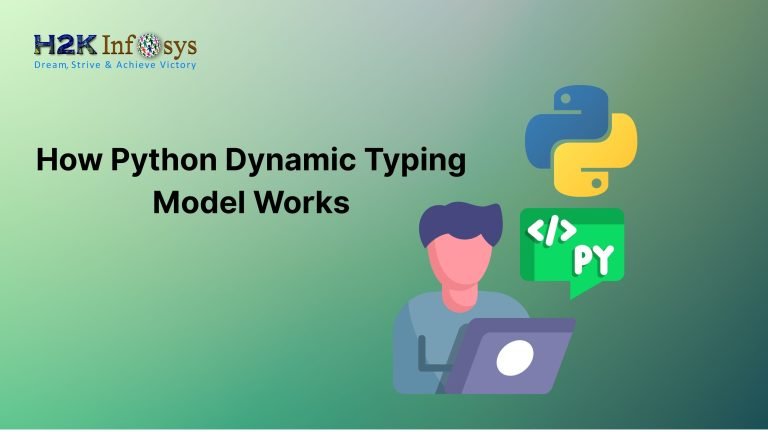Introduction: Why Python’s Dynamic Typing Matters
Python has become the backbone of AI, web development, and full stack applications, largely because of its flexible and developer-friendly nature. One of the most powerful features that sets Python apart is its dynamic typing model. Unlike statically typed languages, where developers must declare variable types in advance, Python lets you focus on solving problems instead of getting stuck with rigid syntax rules.
This adaptability makes Python the top choice for learners pursuing AI for Python, Python AI courses, Python full stack training, and AI Python certification programs. In this blog, we’ll break down how Python Dynamic Typing works, why it’s valuable, and how you can leverage it in real-world projects.
What is Python Dynamic Typing?
Python Dynamic Typing means that the type of a variable is determined at runtime, not at the time of declaration. You don’t need to define whether a variable is an integer, string, or float before using it. Python assigns types automatically based on the value stored.
Example:
# Dynamic typing in action
x = 10 # integer
print(type(x)) # <class 'int'>
x = "Hello AI"
print(type(x)) # <class 'str'>
Here, the same variable x changes from an integer to a string. Python’s runtime system manages this seamlessly, showing the core principle of Python Dynamic Typing.
How Python Dynamic Typing Works Internally
To understand Python Dynamic Typing deeply, let’s explore the steps:
- Variable Declaration: You assign a value to a variable without defining its type.
- Runtime Binding: The interpreter assigns a type at runtime based on the value.
- Memory Management: Python uses reference counting and garbage collection to handle objects dynamically.
- Type Switching: Variables can be reassigned to hold values of different types without errors.
This runtime typing makes Python more flexible for rapid prototyping and development, especially in AI Python certification projects.
Advantages of Python Dynamic Typing
Dynamic typing is not just a convenience, it’s a competitive advantage in professional coding.
1. Rapid Development
Developers can write and test code faster without worrying about type declarations. This accelerates learning for students in a Python AI course.
2. Flexibility in AI and Full Stack Projects
AI models and web applications often require handling diverse data formats. With Python Dynamic Typing, variables can adapt on the go.
3. Ease of Learning
Beginners in Python full stack training can focus on problem-solving instead of wrestling with strict type rules.
4. Prototyping and Experimentation
AI researchers rely on Python to test algorithms quickly. Dynamic typing makes it simple to switch between data structures or test models without rewriting code.
Disadvantages of Python Dynamic Typing
While Python Dynamic Typing is powerful, it also comes with trade-offs.
- Runtime Errors: Since types are not checked at compile-time, type mismatches may cause runtime crashes.
- Performance Issues: Dynamic typing can make execution slower compared to statically typed languages.
- Maintainability Challenges: Large projects may face debugging difficulties if variable types change unexpectedly.
Example:
def add_numbers(a, b):
return a + b
print(add_numbers(10, 20)) # Works fine
print(add_numbers("AI", 20)) # Runtime error: TypeError
In AI-driven applications, developers must be extra cautious with type handling.
Real-World Applications of Python Dynamic Typing
1. AI for Python
In artificial intelligence, datasets often mix integers, strings, and floating-point numbers. With Python Dynamic Typing, AI developers can manipulate these without strict type rules.
Example:
data = [10, "AI", 3.14]
for item in data:
print(f"Value: {item}, Type: {type(item)}")
This flexibility supports building adaptive AI models that can process heterogeneous data sources.
2. Python Full Stack Training Projects
Full stack developers benefit from dynamic typing in handling JSON, APIs, and databases. For example, a variable may store user input as a string, then later convert it to a number for calculations.
user_age = "25"
user_age = int(user_age) + 5
print(user_age) # 30
Dynamic typing ensures seamless data transitions between front-end and back-end systems.
3. Prototyping AI Models
During a Python AI course, students experiment with models using different data formats. Python Dynamic Typing allows quick changes in input types without rewriting functions.
Example:
import numpy as np
x = np.array([1, 2, 3]) # integer array
x = np.array([1.2, 3.4]) # float array
4. Machine Learning Data Pipelines
In real-world machine learning, data often comes from CSV, APIs, or sensors. With Python Dynamic Typing, pipelines can flexibly handle evolving data types.
Python Dynamic Typing vs Static Typing
| Feature | Python Dynamic Typing | Static Typing (e.g., Java, C++) |
|---|---|---|
| Type Checking | At runtime | At compile-time |
| Flexibility | High | Low |
| Error Detection | Runtime | Compile-time |
| Development Speed | Fast | Slower |
| Performance | Slightly slower | Faster |
This comparison shows why Python dominates AI and data science flexibility matters more than execution speed in most cases.
Best Practices for Using Python Dynamic Typing
To make the most of Python Dynamic Typing, follow these practices:
- Use Type Hints
Even though Python is dynamically typed, you can use type hints for clarity.
def greet(name: str) -> str:
return f"Hello, {name}"
- Validate Input Data
Always validate data types when working on AI or full stack projects. - Use Unit Tests
Automated tests can catch runtime errors caused by unexpected type changes. - Leverage IDEs and Linters
Tools like Pylint can analyze your code for type-related risks.
Hands-On Tutorial: Working with Python Dynamic Typing
Let’s walk through a small example relevant to AI Python certification training.
Scenario: Predicting Student Scores
# Dataset: mixed data input
students = {
"Alice": 85,
"Bob": "90", # score as string
"Charlie": 78.5
}
# Normalize scores to float
normalized_scores = {}
for student, score in students.items():
normalized_scores[student] = float(score)
print(normalized_scores)
Output:
{'Alice': 85.0, 'Bob': 90.0, 'Charlie': 78.5}
This flexibility highlights how Python Dynamic Typing simplifies handling inconsistent data in AI projects.
Industry Insights: Why Companies Prefer Python
- AI Research Labs: 85% of AI research papers use Python due to its flexible typing and large library ecosystem.
- Web Development: Over 70% of full stack developers prefer Python for backend flexibility.
- Career Opportunities: Companies actively seek professionals with AI for Python and Python full stack training expertise, making it one of the fastest-growing career paths.
Key Takeaways
- Python Dynamic Typing allows variables to change type at runtime.
- It supports rapid prototyping, flexibility, and easy learning, crucial for AI and full stack projects.
- While it introduces risks like runtime errors, best practices such as type hints and testing minimize issues.
- Mastering dynamic typing is essential for learners pursuing Python AI course, AI Python certification, and Python full stack training.
Conclusion
Python Dynamic Typing is more than a coding feature it’s a game-changer for innovation in AI, data science, and full stack development. By mastering it through expert-led training, you gain the skills to build real-world applications with confidence.
👉 Enroll in H2K Infosys’ AI Powered Full Stack Python Mastery Training today and take your career to the next level!


























